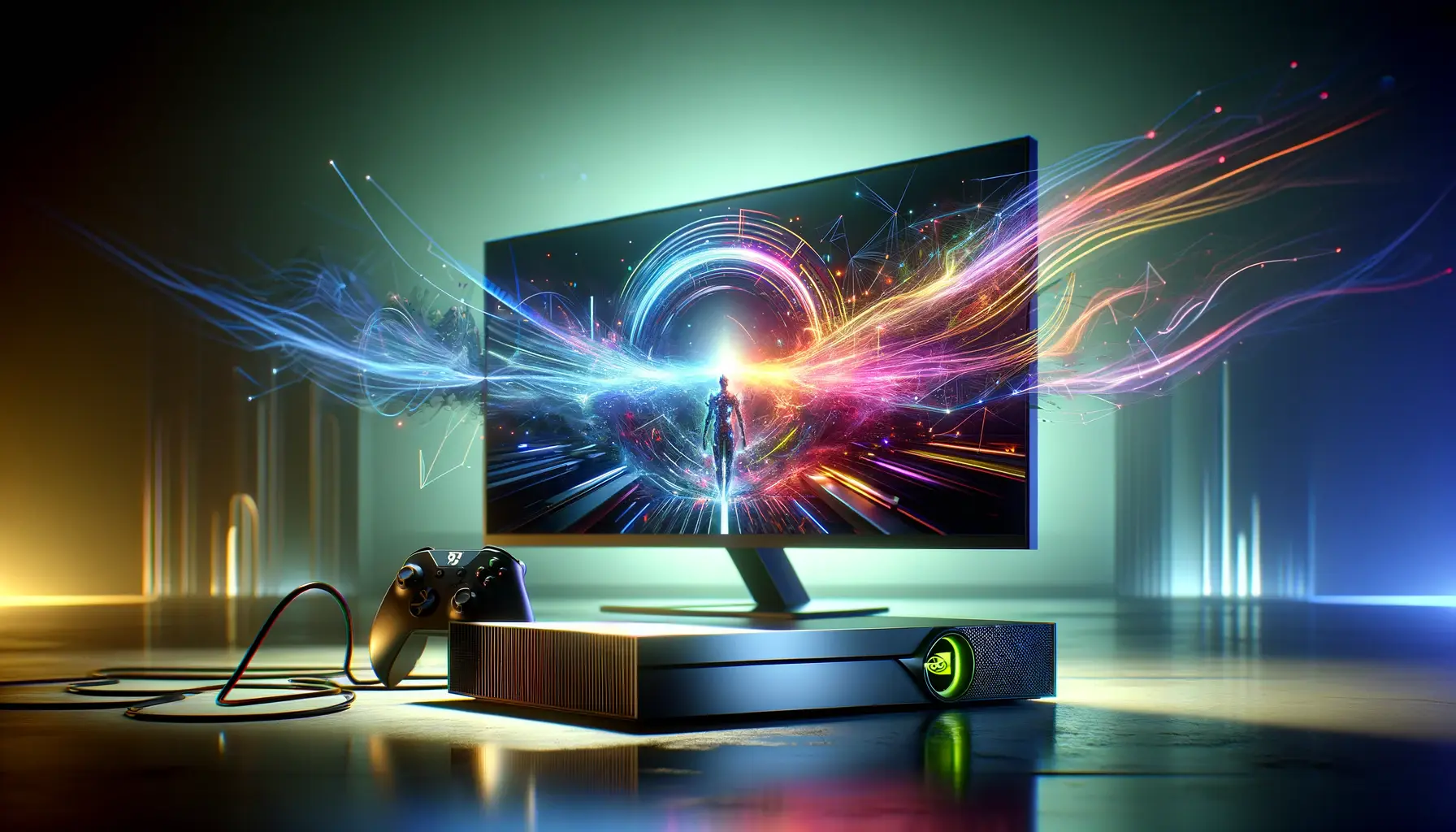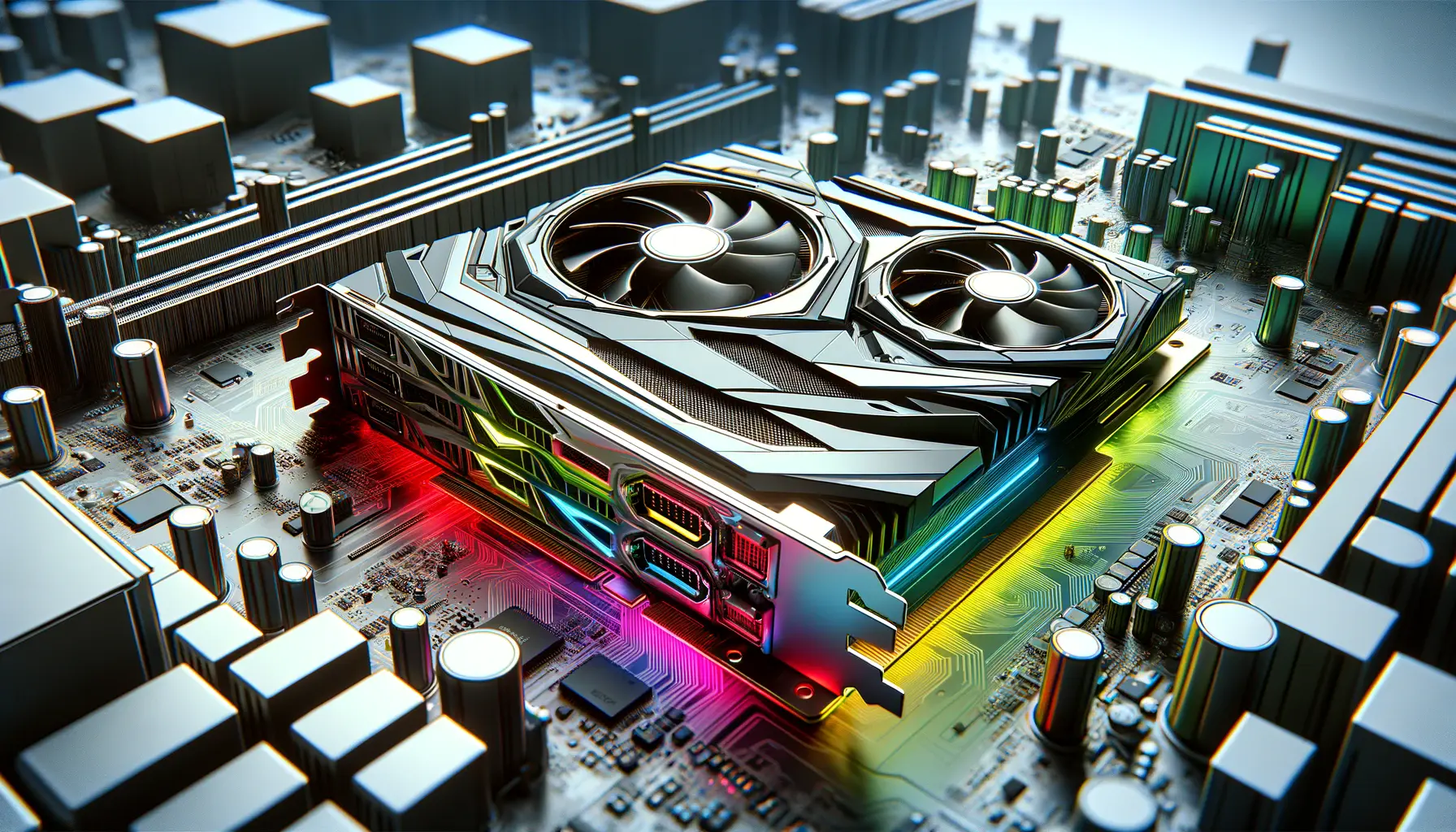The advent of Deep Learning Super Sampling (DLSS) technology by NVIDIA has marked a significant milestone in the realm of gaming and graphics rendering.
DLSS 3, the latest iteration, stands at the forefront of this innovation, showcasing the power of artificial intelligence in enhancing gaming experiences.
This technology not only improves frame rates but also maintains, and in some cases, enhances the visual fidelity of games on supported hardware.
The core of DLSS 3’s magic lies in its AI-driven model, which has been meticulously trained to generate high-quality images from lower-resolution inputs.
At its heart, DLSS 3 leverages advanced AI algorithms and NVIDIA’s vast computing resources to learn and predict high-resolution frames from lower-resolution ones.
This process involves training the AI model on a supercomputer using a dataset of high-quality game frames.
The result is a model capable of upscaling images in real-time, allowing gamers to enjoy stunning visuals without compromising on performance.
The training of the AI model is a complex, resource-intensive process that underscores NVIDIA’s commitment to pushing the boundaries of what’s possible in graphics technology.
- Understanding DLSS 3 Technology
- The Training Process Behind DLSS 3
- DLSS 3’s Impact on Gaming Performance
- Compatibility and Integration of DLSS 3
- DLSS 3 and the Future of AI in Gaming
- Optimizing Gaming Workflows with DLSS 3
- Community and Industry Reception of DLSS 3
- Embracing the Future with DLSS 3
- DLSS 3: Frequently Asked Questions
Understanding DLSS 3 Technology
The Foundation of DLSS 3
Deep Learning Super Sampling, or DLSS, is a revolutionary technology developed by NVIDIA that utilizes neural networks to upscale lower-resolution images in real-time.
DLSS 3, the latest version, introduces significant advancements over its predecessors, including the ability to generate entirely new frames.
This innovation significantly boosts performance while maintaining, and in some cases improving, the visual quality of games.
The technology behind DLSS 3 is grounded in the training of a sophisticated AI model.
This model is trained on a diverse dataset of high-quality, 16K rendered images of numerous games.
By analyzing these images, the AI learns how to accurately predict and generate high-resolution images from lower-resolution inputs.
The training process is both time-consuming and computationally intensive, requiring the use of NVIDIA’s supercomputers.
However, the outcome is a model that can instantly upscale images, enhancing both the efficiency and quality of graphics rendering.
How DLSS 3 Enhances Gaming Experiences
DLSS 3’s impact on gaming is profound.
By enabling higher frame rates without sacrificing image quality, it allows gamers to experience their favorite titles in unprecedented detail and smoothness.
This is particularly beneficial for users with less powerful hardware, as it provides a way to enjoy high-quality visuals without needing to upgrade to the latest GPU models.
Furthermore, DLSS 3’s frame generation capability introduces a new level of performance optimization, effectively doubling the frame output in certain scenarios.
Another key advantage of DLSS 3 is its adaptability.
The AI model is continuously improved and updated by NVIDIA, ensuring compatibility with a wide range of games and scenarios.
This ongoing training process means that DLSS technology gets better over time, with each update offering enhanced performance and visual fidelity.
For developers, integrating DLSS 3 into their games opens up new possibilities for creating visually stunning experiences without the traditional trade-offs between quality and performance.
DLSS 3 represents a significant leap forward in AI-driven graphics technology, offering both performance improvements and enhanced visual quality for a wide range of games.
The Training Process Behind DLSS 3
The development of DLSS 3’s AI model is a testament to NVIDIA’s commitment to innovation in the field of artificial intelligence and graphics rendering.
The training process is intricate, leveraging vast datasets and computing power to teach the AI how to accurately upscale images.
This section delves into the specifics of how DLSS 3’s AI model is trained, highlighting the technological marvels and challenges encountered along the way.
Training the DLSS 3 AI model begins with the collection of high-quality images from a wide array of games.
These images serve as the foundation for teaching the AI the nuances of different visual elements, from textures and shadows to lighting and reflections.
The diversity of the dataset ensures that the AI model develops a comprehensive understanding of various graphical styles and techniques.
Key Stages of AI Model Training
- Data Collection: NVIDIA gathers thousands of high-resolution, 16K rendered images from numerous games. This extensive dataset includes a variety of scenes, lighting conditions, and textures to cover a broad spectrum of graphical elements.
- Preprocessing: The collected images undergo preprocessing to optimize them for the training process. This step involves adjusting the images to a uniform scale and format, ensuring consistency across the dataset.
- Model Training: Utilizing NVIDIA’s supercomputers, the AI model is trained on the preprocessed images. This phase involves running the model through numerous iterations, gradually refining its ability to predict and generate high-resolution images from lower-resolution inputs.
- Optimization: After the initial training, the model undergoes further optimization to enhance its efficiency and accuracy. NVIDIA’s engineers fine-tune the model, adjusting parameters and algorithms to improve performance and reduce computational overhead.
- Validation and Testing: The trained AI model is rigorously tested across a wide range of games and scenarios. This validation process ensures that the model performs consistently, delivering high-quality upscaling and frame generation across different titles.
The training process for DLSS 3’s AI model is both resource-intensive and time-consuming.
It requires the coordination of NVIDIA’s vast computational resources and expertise in artificial intelligence.
However, the result is a highly sophisticated model capable of transforming the gaming experience by providing smoother performance and enhanced visual quality.
The continuous improvement and optimization of the DLSS 3 AI model underscore NVIDIA’s dedication to pushing the boundaries of gaming technology.
DLSS 3’s Impact on Gaming Performance
The introduction of DLSS 3 has been a game-changer in the realm of PC gaming, offering unprecedented improvements in both performance and visual quality.
This technology allows games to run at higher frame rates without compromising on the graphical fidelity, a feat that was previously challenging to achieve.
The impact of DLSS 3 on gaming performance extends beyond just enhanced visuals, contributing to a smoother and more immersive gaming experience.
Enhanced Frame Rates
One of the most significant benefits of DLSS 3 is its ability to dramatically increase frame rates.
By intelligently generating additional frames, DLSS 3 enables games to run at a much higher FPS (frames per second) than would be possible with traditional rendering techniques.
This improvement is particularly noticeable in graphically intensive titles, where maintaining a high frame rate can be challenging.
- Games that previously struggled to maintain 60 FPS at high resolutions can now achieve these frame rates with ease, thanks to DLSS 3.
- In some cases, DLSS 3 has been shown to double the frame rate, providing a fluid and responsive gaming experience even in demanding scenarios.
Improved Visual Quality
DLSS 3 not only boosts performance but also enhances the visual quality of games.
By upscaling images from a lower resolution, DLSS 3 maintains sharpness and detail, often producing results that are indistinguishable from native high-resolution rendering.
This technology ensures that gamers do not have to choose between performance and visual quality, offering the best of both worlds.
- Textures, shadows, and lighting are rendered with greater precision, contributing to a more immersive and realistic gaming environment.
- Visual artifacts and blurring, common issues with traditional upscaling methods, are significantly reduced, resulting in cleaner and more detailed images.
Reduced Hardware Requirements
DLSS 3 also has a profound impact on hardware requirements for gaming.
By offloading some of the graphical processing to AI, DLSS 3 allows gamers to achieve high-quality visuals without needing the latest and most powerful hardware.
This democratization of high-end gaming experiences makes cutting-edge visuals accessible to a broader audience.
- Players with older or mid-range GPUs can enjoy games at higher settings and resolutions that were previously only achievable with top-tier hardware.
- This technology extends the lifespan of existing hardware, reducing the need for frequent upgrades and making PC gaming more sustainable and cost-effective.
The transformative impact of DLSS 3 on gaming performance and visual quality signifies a major leap forward in PC gaming technology, setting new standards for what gamers can expect from their hardware.
Compatibility and Integration of DLSS 3
DLSS 3’s groundbreaking technology has not only revolutionized gaming performance but also raised questions about compatibility and integration with existing and future gaming titles.
NVIDIA has worked closely with game developers and publishers to ensure that DLSS 3 can be seamlessly integrated into a wide range of games, offering benefits across various genres and platforms.
Wide Range of Supported Titles
One of the key strengths of DLSS 3 is its support for a diverse portfolio of games.
From blockbuster AAA titles to indie gems, NVIDIA’s technology is becoming increasingly ubiquitous, thanks to its open integration approach.
This wide adoption is crucial for gamers who wish to experience the full benefits of DLSS 3 across their gaming library.
- Major game engines like Unreal Engine and Unity have integrated DLSS 3 support, making it easier for developers to implement the technology in their games.
- NVIDIA collaborates with developers during the game development process to optimize DLSS 3 performance, ensuring that gamers receive the best possible experience from day one.
Future-Proofing Gaming Experiences
DLSS 3 is not just about enhancing current gaming experiences; it’s also about future-proofing them.
As game graphics continue to evolve, becoming more detailed and complex, DLSS 3 ensures that gamers can enjoy these advancements without the constant need for hardware upgrades.
This aspect of DLSS 3 is particularly appealing to gamers looking to maximize the longevity of their gaming setups.
- By continuously updating the DLSS 3 AI model, NVIDIA ensures that the technology remains effective and efficient with new game releases and graphical updates.
- The adaptability of DLSS 3 to different resolutions and performance requirements makes it a versatile tool for both current and future gaming needs.
Challenges in Integration
Despite its many benefits, integrating DLSS 3 into games is not without challenges.
The technology requires specific support from the game’s engine and careful optimization to achieve the desired balance between performance and visual quality.
NVIDIA provides extensive documentation and support to developers, but the integration process can still be complex and time-consuming.
- Some developers may face hurdles in fine-tuning DLSS 3 settings to match their game’s unique visual style and performance characteristics.
- Ensuring compatibility across a wide range of hardware configurations also presents challenges, requiring thorough testing and optimization.
The widespread compatibility and integration of DLSS 3 across the gaming industry underscore its importance as a transformative technology, despite the challenges involved in its implementation.
DLSS 3 and the Future of AI in Gaming
The integration of DLSS 3 into the gaming landscape marks a pivotal moment in the utilization of artificial intelligence within the industry.
As developers and gamers alike begin to witness the tangible benefits of AI-driven technologies, the future of gaming appears increasingly intertwined with advancements in AI.
This evolution promises not only to elevate gaming experiences but also to redefine the capabilities of gaming hardware and software.
Expanding the Horizons of Realism
DLSS 3’s ability to enhance image quality and performance is just the beginning.
The technology’s underlying AI has the potential to further blur the lines between virtual and reality, offering gamers experiences that are more immersive and realistic than ever before.
As AI continues to evolve, we can expect to see even more sophisticated applications that will push the boundaries of what’s possible in game design and graphics.
- Future iterations of DLSS could improve aspects of gaming beyond resolution and frame rates, such as AI-driven dynamic lighting, advanced physics simulations, and more lifelike character animations.
- The continuous learning aspect of AI models means that these technologies will only improve over time, adapting to new gaming trends and graphical innovations.
Democratizing High-End Gaming
One of the most significant impacts of DLSS 3 and similar AI technologies is their potential to democratize high-end gaming experiences.
By reducing the need for cutting-edge hardware to achieve premium visual quality and performance, AI can make top-tier gaming more accessible to a broader audience.
This inclusivity could significantly alter the gaming landscape, making it more diverse and vibrant.
- Players with older or less powerful systems can enjoy enhanced gaming experiences without the prohibitive cost of frequent hardware upgrades.
- This accessibility could lead to a larger, more engaged gaming community, fostering increased creativity and innovation within the industry.
Challenges and Considerations
While the future of AI in gaming is bright, it also presents new challenges and ethical considerations.
The reliance on AI and machine learning raises questions about data privacy, the environmental impact of training AI models, and the potential for AI to influence game design in ways that prioritize technological showcase over gameplay.
- Developers and companies will need to navigate these challenges carefully, ensuring that AI enhances rather than detracts from the gaming experience.
- As AI becomes more prevalent in gaming, there will also be a need for transparency regarding how AI is used and the implications for players.
The integration of DLSS 3 into gaming is just the beginning of a broader AI revolution within the industry. As we look to the future, the possibilities for AI to enhance and transform gaming are limitless, promising a new era of immersive, accessible, and realistic gaming experiences.
Optimizing Gaming Workflows with DLSS 3
The advent of DLSS 3 technology not only revolutionizes the gaming experience for players but also significantly impacts the development process behind the scenes.
By harnessing the power of AI to enhance graphics performance, game developers can optimize their workflows, enabling more efficient use of resources and time.
This optimization has far-reaching implications for the gaming industry, paving the way for more innovative and visually stunning titles.
Streamlining Development Processes
DLSS 3 allows developers to focus on creativity and innovation without being overly constrained by hardware limitations.
By relying on AI to upscale graphics and improve frame rates, developers can design games with high-quality assets and complex visual effects, knowing that DLSS 3 will ensure smooth performance across a wide range of systems.
- Reduces the need for manual optimization of graphics settings for different hardware configurations, saving developers time and resources.
- Enables smaller studios to create visually impressive games without the need for a large budget dedicated to optimization and testing.
Enhancing Creative Possibilities
With DLSS 3, the barrier to achieving photorealistic graphics is significantly lowered.
This technological advancement opens up new creative possibilities, allowing developers to experiment with ambitious visual concepts and storytelling techniques that were previously impractical due to performance constraints.
- Facilitates the creation of more dynamic and interactive environments, with detailed textures and effects that react to player actions in real-time.
- Supports advanced lighting and shadow techniques, contributing to more immersive and emotionally engaging game worlds.
Future Workflow Innovations
As DLSS technology continues to evolve, it’s expected to introduce further innovations in game development workflows.
NVIDIA’s ongoing research and development in AI and machine learning suggest that future versions of DLSS could automate even more aspects of the game development process, from AI-assisted asset creation to dynamic difficulty adjustments based on player performance.
- Potential for AI-driven tools that automatically generate high-quality assets, reducing the workload on artists and designers.
- Opportunities for real-time AI adjustments to game mechanics, ensuring a balanced and enjoyable experience for players of all skill levels.
DLSS 3 represents a paradigm shift in game development, offering developers the tools to push the boundaries of what’s possible in video games while optimizing their workflows for efficiency and creativity.
Community and Industry Reception of DLSS 3
The launch of DLSS 3 has sparked considerable interest and discussion within the gaming community and industry.
Its innovative approach to leveraging AI for enhancing gaming performance and visual quality has been met with both excitement and scrutiny.
This reception highlights the technology’s impact and the broader implications for the future of gaming.
Gamer Feedback and Experiences
Gamers who have experienced DLSS 3 firsthand often report significant improvements in gameplay smoothness and visual fidelity.
The ability to play demanding titles at higher frame rates without sacrificing quality has been particularly praised.
However, some users have expressed concerns about the technology’s availability, primarily limited to newer NVIDIA GPUs, and the variability of performance gains across different titles.
- Positive feedback centers on the transformative gaming experiences enabled by DLSS 3, with many users highlighting the technology as a deciding factor in GPU purchases.
- Critical voices point to the need for broader support and optimization across more games, as well as a desire for similar advancements on platforms beyond PC gaming.
Impact on Game Development
The industry’s response to DLSS 3 has been largely positive, with many developers eager to integrate the technology into their titles.
The promise of DLSS 3 to deliver high-quality visuals at improved performance levels has encouraged developers to adopt the technology, leading to a growing list of supported games.
However, the integration process poses challenges, including the need for close collaboration with NVIDIA and technical adjustments to game engines.
- Developers appreciate DLSS 3 for its potential to elevate visual quality and performance, making it a valuable tool in the competitive gaming market.
- The challenges of integrating DLSS 3, while notable, are generally viewed as worthwhile for the benefits the technology offers to both developers and gamers.
Looking Ahead: DLSS 3 and the Evolution of Gaming
The reception of DLSS 3 underscores its role as a catalyst for change in the gaming industry.
As the technology matures and its adoption widens, it is poised to shape the development and consumption of video games in profound ways.
The ongoing dialogue between NVIDIA, game developers, and the gaming community will be crucial in addressing concerns, expanding support, and realizing the full potential of AI in gaming.
- The future of DLSS 3 and similar AI technologies lies in their ability to democratize access to high-quality gaming experiences, making them available to a wider audience.
- Continued innovation and collaboration will be key to overcoming current limitations and unlocking new possibilities for gamers and developers alike.
While DLSS 3 has been met with enthusiasm, it also highlights the importance of ongoing development, optimization, and dialogue to ensure the technology meets the evolving needs of the gaming community and industry.
Embracing the Future with DLSS 3
The journey through the intricacies of DLSS 3 reveals a technology that stands at the confluence of innovation, gaming performance, and visual fidelity.
As we’ve explored the depths of DLSS 3’s AI-driven model, its profound impact on gaming workflows, and the broader implications for the gaming community and industry, it’s clear that NVIDIA’s technology is not just a fleeting advancement but a cornerstone for the future of gaming.
The Path Forward for Gamers and Developers
For gamers, DLSS 3 offers a glimpse into a future where the boundaries of hardware limitations are continually pushed further away.
The ability to experience ultra-high-definition gaming without the need for prohibitively expensive hardware is a testament to the power of AI in transforming user experiences.
Meanwhile, developers are given a tool that not only enhances the visual quality of their creations but also streamlines their development processes, allowing for greater focus on creativity and innovation.
Challenges and Opportunities
Despite the enthusiasm surrounding DLSS 3, the technology’s journey is not without its challenges.
The limited availability to newer NVIDIA GPUs and the variability in performance gains across different titles are concerns that NVIDIA and the gaming industry will need to address.
However, these challenges also present opportunities for growth and improvement.
As DLSS 3 continues to evolve, so too will its integration processes, support for a wider range of titles, and accessibility for a broader audience.
- Expansion of DLSS 3 support to more games and platforms, ensuring a more inclusive gaming experience.
- Continuous dialogue between NVIDIA, developers, and gamers to refine and optimize the technology.
- Further research and development in AI to unlock new possibilities in gaming, beyond just graphics rendering.
Conclusion: A New Era of Gaming
In conclusion, DLSS 3 is more than just a technological marvel; it’s a beacon for the future of gaming.
By harnessing the power of AI, NVIDIA has not only enhanced the gaming experience for players today but has also laid the groundwork for the innovations of tomorrow.
As we look forward to the continued evolution of DLSS 3 and its impact on the industry, one thing is clear: the future of gaming is bright, and it’s being shaped by the incredible potential of AI.
DLSS 3: Frequently Asked Questions
Explore the most common inquiries about NVIDIA’s DLSS 3 technology, offering insights into its functionality, benefits, and integration.
DLSS 3 is NVIDIA’s AI-driven technology that enhances gaming performance and visual quality by intelligently upscaling images and generating additional frames.
DLSS 3 is supported on NVIDIA GeForce RTX 40 Series GPUs, leveraging their advanced AI capabilities for optimal performance.
Yes, DLSS 3 significantly improves frame rates by generating additional frames, enhancing gameplay smoothness without compromising visual quality.
DLSS 3 enhances visuals by upscaling lower-resolution images to higher fidelity, maintaining or even improving the game’s graphical quality.
DLSS 3 introduces frame generation and NVIDIA Reflex, offering substantial performance boosts and reduced latency compared to earlier versions.
DLSS 3 is being progressively integrated into games, with a growing list of titles supporting the technology for enhanced performance.
Developers integrate DLSS 3 through NVIDIA’s SDK, optimizing their games to leverage the AI-driven enhancements DLSS 3 offers.
DLSS 3 offers gamers higher frame rates, improved visual quality, and a smoother gaming experience across supported titles and hardware.













